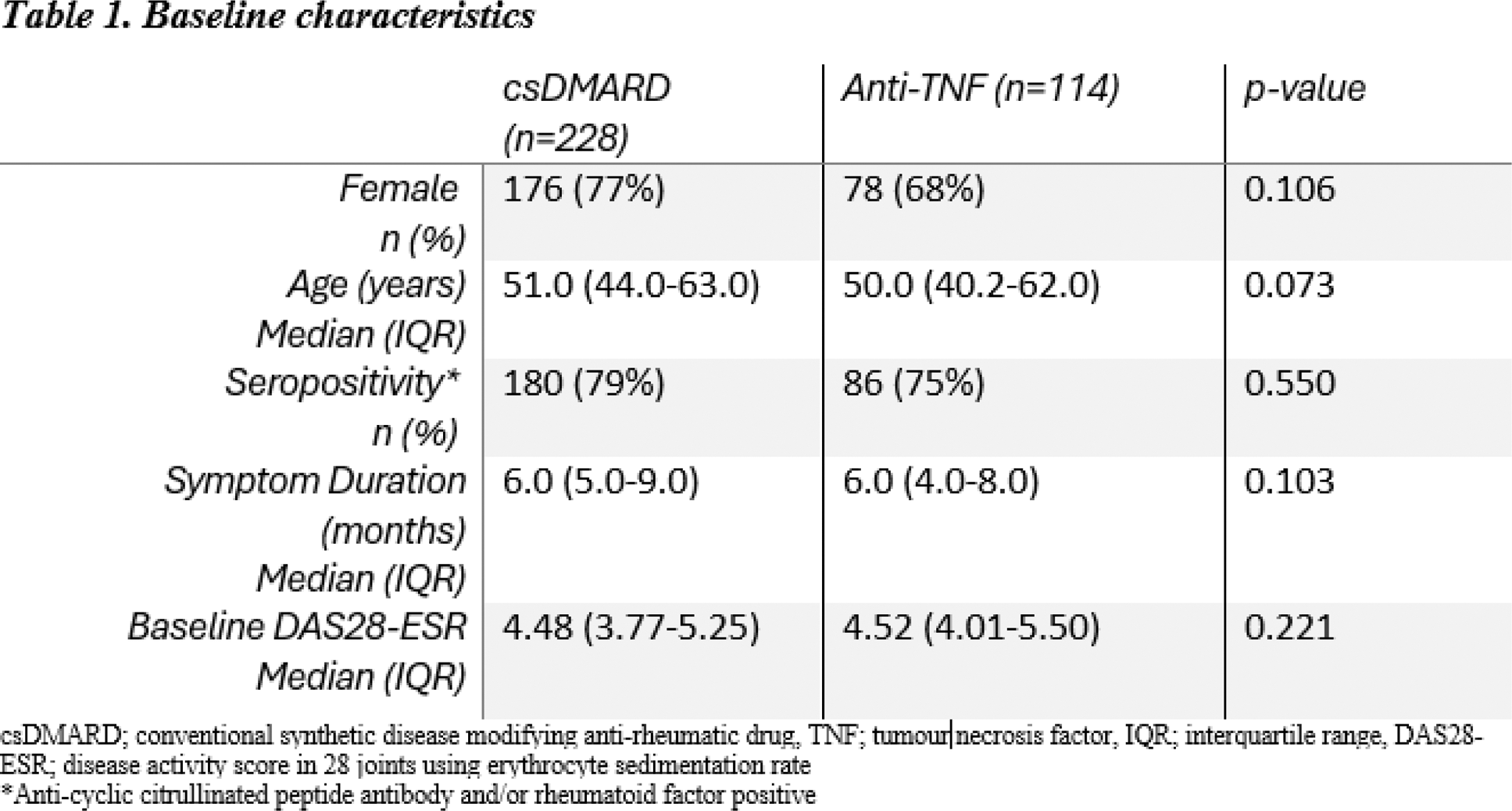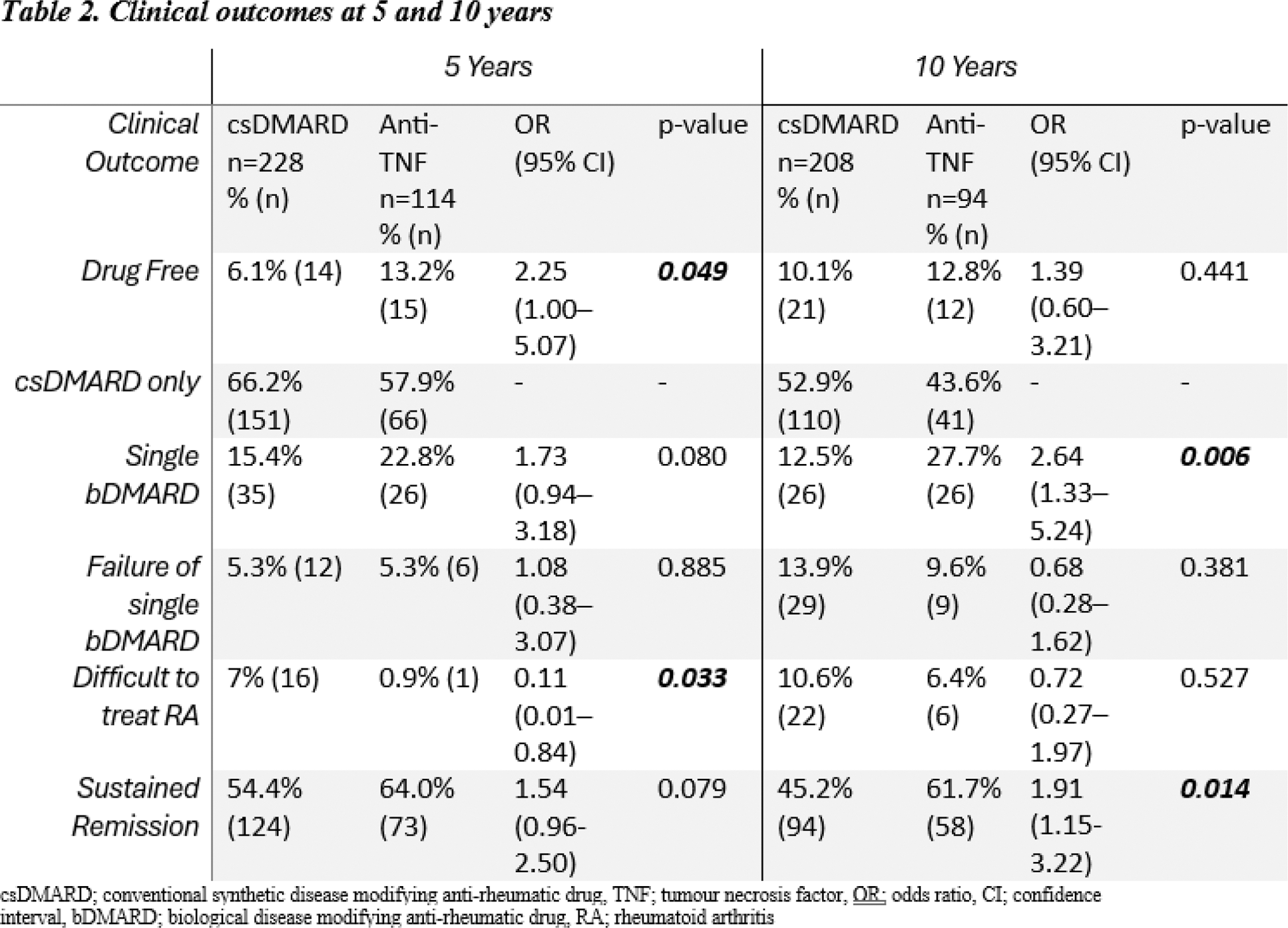

Background: While conventional synthetic disease modifying anti-rheumatic drugs (csDMARDs) remain first line therapy in early rheumatoid arthritis (RA), most patients do not achieve sustained remission, and a subgroup go on to develop difficult-to-treat (D2T) or polyrefractory disease. More effective remission induction is achieved by first line biologic DMARDs (bDMARDs), with a comparable safety profile to csDMARDs in clinical trials. A dramatic fall in treatment costs through biosimilar use further support the health economic argument for first line bDMARD use, particularly for anti-TNF drugs. However, in addition to the early benefits on remission induction, it is also critical to understand whether first line bDMARDs deliver better long-term outcomes compared with a csDMARD treat-to-target approach.
Objectives: To compare long-term clinical outcomes, including D2T status, in RA patients who received first line anti-TNF therapy vs usual care with csDMARDs
Methods: The Leeds Inflammatory Arthritis CONtinuum cohort was used to identify DMARD-naive early RA patients (1987 ACR or 2010 ACR/EULAR classification criteria) who received an anti-TNF drug as first-line induction therapy for 12 months as part of a clinical trial. Covariate (age, sex, seropositivity, symptom duration, baseline disease activity) and time (diagnosis and treatment period) matched early RA patients who received usual care with csDMARD therapy in a treat-to-target strategy were used as controls. All patients had a minimum follow-up duration of 5 years from diagnosis. Treatment outcomes were assessed at 5 and 10 years and categorised as follows: 1) drug free remission, 2) csDMARDs only, 3) single bDMARD, 4) failure of one class of bDMARD or 5) failure of ≥2 mechanism of actions (MoA) of b/tsDMARDs, i.e. criterion #1 of the EULAR definition of D2TRA [1]. Rates of sustained remission, defined as DAS28 remission or clinician-documented remission for ≥6 months and the time to first bDMARD were evaluated. Multinomial logistic regression (with ‘csDMARD only’ as the reference level), binary logistic regression and Wilcoxon rank-sum test were used for the analyses.
Results: 114 anti-TNF induction patients and 228 matched controls with RA, diagnosed between 2007-2015, were included. Baseline characteristics were similar between groups (Table 1). All cases that satisfied “failure of ≥2 MoA b/tsDMARDs” also fulfilled all three criteria of the EULAR definition for D2TRA. At 5 years, only 0.9% were D2T in the anti-TNF group compared to 7% in the controls (OR 0.11, 95% CI 0.01-0.84, p=0.033) (Table 2). Rates of drug free remission were also significantly higher in the anti-TNF group compared to the controls at 5 years (13.2% vs 6.1%, OR 2.25, 95% CI 1.00-5.07, p=0.049). Eighty-eight percent of all patients had 10-year follow-up data available. The differences in rates of D2TRA and drug free remission at 10 years were no longer apparent. However, a significantly higher proportion of patients who received anti-TNF induction therapy were on single bDMARD at 10 years compared to the csDMARD controls (27.7% vs 12.5%, OR 2.64, 95% CI 1.33-5.24, p=0.006). Sustained remission was more frequent in the anti-TNF group compared with controls at 10 years (62% vs 45%, adjusted OR 1.91 95% CI 1.15-3.22, p=0.014). The median adjusted time to require escalation to biologic therapy was 52.5 months in the anti-TNF group compared to 39.3 months in the control group (Cohen’s d = -0.46, p=0.019).
Conclusion: These data suggest first line anti-TNF induction therapy in RA is associated with better long-term clinical outcomes compared with usual treat-to-target care with csDMARDs. Fewer than 1% of anti-TNF treated patients were D2T at 5 years. Furthermore, fewer anti-TNF treated patients required ≥2 bDMARDs/tsDMARDs at 10 years and a higher proportion achieved sustained remission. This real-world study further highlights the potential benefits, including costs, to be realised from adopting routine first line bDMARD use in early RA.
REFERENCES: [1] Nagy G, Roodenrijs NM, Welsing PM, et al. (2021) EULAR definition of difficult-to-treat rheumatoid arthritis. Ann Rheum Dis, 80(1), 31–35.


Acknowledgements: NIL.
Disclosure of Interests: Task Toyoda: None declared, Kerem Abacar: None declared, Farag Shuweihdi: None declared, Megan Sheridan: None declared, Jacqueline Nam: None declared, Ai Lyn Tan: None declared, Lesley-Anne Bissell: None declared, Paul Emery Abbvie, Activa, Astra-Zeneca, BMS, Boehringer Ingelheim, Galapagos, Gilead, Immunovant, Janssen, Lilly, Novartis, Abbvie, BMS, Lilly, Novartis, Pfizer, Samsung, Kulveer Mankia Abbvie, ALLin Bio, Astra Zeneca, UCB, Lilly, Galapagos, Serac Healthcare, Zura Bio, Deepcure, Gilead, Lilly, Serac Healthcare, Astra Zeneca, Deepcure.
© The Authors 2025. This abstract is an open access article published in Annals of Rheumatic Diseases under the CC BY-NC-ND license (